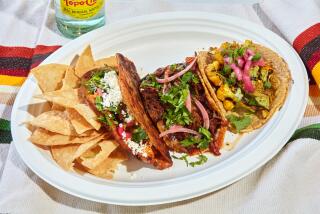A Very Civilized Affair : Picnics: When Victorians ate outdoors, they brought their dining rooms with them.
- Share via
“It is to be all out of doors, a table spread in the shade, you know. Everything as natural and simple as possible. Is that not your idea?” asks Mrs. Elton, the comic character in Jane Austen’s novel, “Emma.”
“Not quite,” replies Mr. Knightley. “My idea of the simple and the natural will be to have the table spread in the dining room.”
When Jane Austen wrote “Emma” in 1816, eating out of doors had not yet really come into fashion. It was in the mid-19th Century that picnics became popular. But once the Victorians discovered them, picnics became a favorite pastime for the fair-weather months.
Louisa May Alcott included a picnic scene in her novel, “Little Women,” first published in 1868. The records of virtually any late 19th-Century church or social association mention huge picnics organized by the womens’ auxiliaries. Nineteenth-Century artists also began painting picnic scenes with elegantly attired figures lolling among idyllic scenery.
Picnicking gained popularity as civilization became increasingly industrialized. As more and more people lived in urban and suburban locations and worked in factories and offices, they began to feel the need to occasionally return to nature and soak up some rustic charm. Many cities began accommodating this phenomenon by setting up picnic groves in parks.
In a way, picnics let people briefly escape the strictures of Victorian parlor etiquette. Yet picnics called for their own proper behavior, which was exhaustively described in etiquette books and household management manuals of the day. The foods eaten and the activities pursued at a Victorian picnic were supposed to illustrate one’s good breeding. There were rules concerning what to wear, what games to play and exactly how much hand holding was allowed for the unmarried couple.
In the 1891 etiquette manual, “Our Manners and Social Customs,” author Daphne Dale stipulated that the picnic meal must be followed by group singing, the playing of musical instruments, the telling of amusing stories and “games and romping--for the rigidest disciplinarian will romp when there is green grass underfoot.” A courting couple might even pair off “and then who shall say what glances may be exchanged?” To keep those glances from leading to anything else, many picnic parties included chaperones, usually one of each sex, to see that young men and women behaved themselves.
In 1884, Mrs. S.D. Power wrote a household management manual called “Anna Maria’s Housekeeper” that included a whole chapter on what to take to a picnic. For comfort, she advocated camp chairs, mats and hammocks. Nineteenth Century art shows us that, as Jane Austen suggested, picnickers did sometimes bring the dining room table. Occasionally an extra wagon was required just for the furniture that picnickers dragged along.
Power included instructions on how to pack one’s china into a picnic hamper, but she also suggested that church parishes acquire sets of unbreakable wooden dishes for the ever-popular church picnic.
She emphasized that all food should be easy to handle. Sandwiches were best, particularly when filled with something that late 19th-Century eaters called a “salad.” This meant cold cooked beef, ham or chicken chopped finely and held together with mayonnaise. This was supposed to be easier to eat neatly than sandwiches filled with slices of meat. If the sandwiches were made beforehand, Power suggested they be separately wrapped in paper and tied with a pretty ribbon.
Power also recommended plain bread and butter for those who preferred it, chunks of cheese, and cold sliced ham, tongue or chicken. For a colorful garnish or side dish, she suggested “pickles.” In her day, “pickles” referred not only to pickled cucumbers but to any pickled vegetables, chutney-type preserves or preserved fruits.
“No, I shall not forget the cake,” Power wrote, “and you may depend on its being the only thing that other people will not forget either.” She recommended pound cake, fruit cake or sponge cake. Gingerbread was also popular.
To wash down this feast, Power proposed cold tea flavored with sugar and lemon, or lemonade made right at the picnic grove by mixing a syrup of lemon juice and sugar with ice water. The syrup and the water were to be packed and brought separately. Some people preferred wine, such as a chilled claret, but Power thought that the healthy fresh air was stimulation enough for one’s digestion.
The foods Power recommended in 1884 are still good picnic choices. But thanks to more than a century of progress, today they’re a lot easier to prepare. For that real Victorian flavor, wicker picnic hampers with room for genuine china and silverware are available in department and gourmet stores.
Power recommended packing plenty of food for the picnickers, but showed her concern for the environment by writing, “The debris, instead of disfiguring the grounds, should be collected in a box and go to somebody’s chickens.”
A Victorian picnic was a very civilized affair.
This recipe is adapted from “Anna Maria’s Housekeeper,” by Mrs. S.D. Power, 1884.
CHICKEN SALAD SANDWICHES
1 pound cold cooked chicken (about 2 boneless breasts)
6 tablespoons chopped parsley
1/4 cup mayonnaise
Salt, pepper
8 slices homemade bread
Chop chicken very fine, or mince. Place chicken in bowl and mix in parsley and just enough mayonnaise to moisten mixture. Season to taste with salt and pepper. Slice bread very thin. Make sandwiches, wrap each in plastic wrap, then in paper napkin and tie with ribbon. Makes 4 sandwiches.
These mushrooms are adapted from William Archdeacon’s book, “Kitchen Cabinet,” a specialized cookbook published in 1876 on “the art of preserving fruits, vegetables and meats by use of vinegar, sugar or salt.”
PICKLED MUSHROOMS
1 pound mushrooms
2 tablespoons butter
4 cloves, crushed
1/4 teaspoon ground mace
Up to 1 cup vinegar
Salt, pepper
Olive oil
3 tablespoons chopped parsley
Wash mushrooms and trim off stems. If mushrooms are large, cut into quarters. Melt butter in skillet. Add cloves and mace. Add mushrooms and saute about 10 minutes or until moisture is released. Remove from heat and let stand about 10 minutes. Do not drain.
Place mushrooms in glass or ceramic container. Add enough vinegar to cover. Let stand at least 1 hour. Longer standing increases vinegary taste. Drain. Season to taste with salt, pepper and olive oil. Stir in parsley before packing. Makes 4 appetizer servings or garnish portions.
Gingerbread was popular throughout the Victorian era. Hard gingerbreads were rolled and cut into cookie shapes; soft gingerbreads had the texture of bread or coffee cake. Frosting was not specifically recommended for gingerbread. Indeed, an unfrosted cake would have been easier to pack for a picnic. If you do want to frost your gingerbread, use a commercial vanilla or cream cheese frosting and decorate with candied violets. Adapted from “Aunt Mena’s Recipe Book,” compiled by M. B. Bosson in 1888.
SOFT GINGERBREAD
1/2 cup butter
1/2 cup sugar
1/2 cup molasses
1/2 teaspoon ground ginger
1/2 teaspoon ground cinnamon
1/2 cup buttermilk
1 egg
2 1/2 cups flour
1 teaspoon salt
3/4 teaspoon baking soda
3/4 teaspoon baking powder
Grease and flour 1 square cake pan or 2 small loaf pans. Cream butter and sugar until light. Add molasses, ginger, cinnamon, buttermilk and egg and beat until smooth. (Don’t be alarmed if ingredients appear to separate.)
Sift together flour, salt, baking soda and baking powder. Add dry ingredients to butter mixture, about 1/2 cup at time, beating after each addition. Toward end, mix by hand as batter will have consistency of peanut butter. Fill baking pans, pressing to fill corners. Bake at 350 degrees 30 to 35 minutes or until top springs back when lightly touched. Cool completely. Makes 8 to 10 servings.
Other Picnic Fixings
You may want to bring some sliced ham or tongue, a commercial chutney and some homemade bread and butter. Old sardine cans have often been found at picnic grounds, indicating that this was another picnic favorite. You might also take a defrosted can of frozen lemonade concentrate and mix it at the picnic site with water and ice carried separately, the way Power suggested.
More to Read
Sign up for The Wild
We’ll help you find the best places to hike, bike and run, as well as the perfect silent spots for meditation and yoga.
You may occasionally receive promotional content from the Los Angeles Times.






